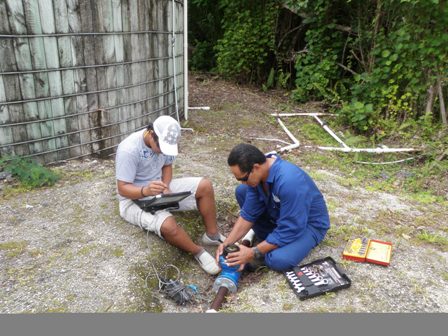News
YES | 1 | YES
Reducing water loss in Niue
25 May, 2010


Water is something most people never really think about. Turn on a tap, flush a toilet, and the expectation is that clean water will be instantly available. For billions of people globally this scenario is still a distant dream.
Niue is one country blessed with a large supply of clean fresh water but it is not something that people should take for granted. Every aspect of Niue’s water supply system has an associated cost - from pumping, storing and distributing water to maintaining infrastructure. Supplying water to Niueans costs Niue’s Public Works Department (PWD) NZ$14,000 a month, or NZ$168,000 annually. Any water that is lost or wasted therefore represents a major cost to government and depletes precious water resources.
In early May, 2010, the PWD’s Water Division worked with Chelsea Giles-Hansen, a Water Demand Management Officer at the Pacific Islands Applied Geoscience Commission (SOPAC), to analyze where and how water is wasted and to update Niue’s System Loss Management Plan.
Losses in Niue are mainly from burst or broken pipes or water wasted from leaking household taps, showers, toilets and outlets. A household tap replacement project run by the PWD, the Water Industry Operators Group of New Zealand and SOPAC in November 2009 found that every second house in Niue had a leak in their plumbing system.
After repairs were carried out in each village, water data meters and loggers were used to measure night flows (these measurements are taken in the middle of the night when, in theory, no one is using water and the assumption can be made that any water leaving the system is loss). The results showed a reduction in night flows of up to 50%. This saving enabled the PWD to turn off one of its groundwater bore pumps (Sp3 Alofi) as the supply was no longer needed.
According to Head of the Water Division, Andre Siohane, significant savings can be made to the cost of supplying water by improving water use efficiency through reducing wastage and leakages.
“Instead of spending money to pump and supply litres of water which is then lost, the government can better spend this money elsewhere, for example on education for Niue’s children or for better healthcare,” Mr Siohane said. “We are in the process of updating our management plan to ensure the people of Niue continue to receive a safe supply of water.”
One of the first recommendations in the Niue system loss management plan was to install flow meters right across the supply system – from bore to consumer. Without this basic but fundamental data on how much water there is and where it is flowing – it is near impossible to effectively manage a water supply system.
Supported by NZ-Aid’s Water Demand Management Programme, flow meters have been installed on all groundwater bores and village reservoirs. Recently household meters in Tamakautoga have also been installed, and will be in Fualahi in the future. These two villages were chosen because one is a gravity system and one uses a pressure pump to supply water to houses. This complete information about how much water is being pumped, stored and used is vital to be able to manage Niue’s precious water efficiently.
© 2024 SPC Water, Sanitation and Hygiene. All rights reserved.